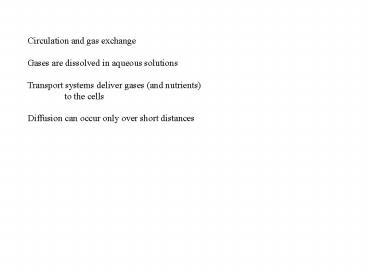Circulation and gas exchange - PowerPoint PPT Presentation
1 / 26
Title: Circulation and gas exchange
1
Circulation and gas exchange Gases are dissolved
in aqueous solutions Transport systems deliver
gases (and nutrients) to the cells Diffusion
can occur only over short distances
2
Gastrovascular cavity Cnidarians have radial
symmetry and a very thin body wall Gastrovascula
r cavity extends into all areas of the
body Flatworms single opening
3
(No Transcript)
4
In more complex animals, too many cell layers tp
allow diffusion through a body cavity Circulatory
systems blood blood vessels heart Open and
closed circulatory systems
5
Earthworms, squids, Octopi, vertebrates
Arthropods, most mollusks
6
General features of cardiovascular system Heart
with atria and ventricles Arteries, veins and
capillaries Complexity of system determined
by metabolic rate type of breathing mechanism
7
(No Transcript)
8
Fish- two-chambered heart Amphibians-
three-chambered heart (one ventricle) Reptiles-
ventricle is partially divided Crocodilians,
birds, mammals- four-chambered heart separates
oxygen-rich from oxygen-poor blood
9
trace a drop of blood
10
Cardiac cycle Flow form atria to
ventricles Controlled by valves Systole,
diastole (contraction, relaxation) Cardiac
output a function of heart rate stroke
volume Can be adjusted to body needs
11
(No Transcript)
12
Control of heart rhythmicity
13
Features of arteries and veins Degree of
musculatures Presence of valves Ability of
expand Venous flow affected by skeletal
muscles, breathing
14
Factors affecting blood flow
fact
15
Circulatory system spreads out in network
of arteries, arterioles and capillaries Overall
surface area greatly increases Blood flow slows
through capillaries
16
(No Transcript)
17
(No Transcript)
18
Peripheral resistance- to blood being
pumped from the heart Controlled by contraction
and relaxation of smooth muscles also by
cardiac output Arterioles can dilate, and
cardiac output can increase, in response to
bodys needs In humans, parallel circuits
through the body can direct blood where it is
most needed
19
(No Transcript)
20
(No Transcript)
21
Gravity is a factor for large terrestrial
animals Blood must be pushed through blood
vessels above the heart Blood pressure must be
adjusted as position changes
22
How does blood deliver substances to cells?
23
Exocytosis Diffusion Osmotic pressure regulates
fluid loss what is osmolarity? what is an
osmotically active substance?
24
(No Transcript)
25
What happens to that lost fluid? About 4L/day
pass from the blood to the tissues Some returns
to venules Some is returned via lymphatic system
26
(No Transcript)































